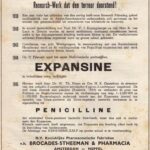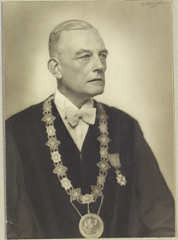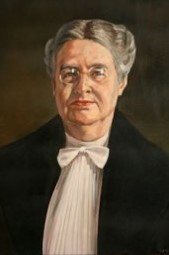When the Oxford team books its first successes, the Germans already occupy the Netherlands for three months. From 1943 onwards, the allies issue a ban on publications on penicillin. And yet, in November 1945 the Nederlandse Gist- en Spiritusfabriek in Delft already cures its first patient with penicillin of its own. There is a very rapid development of penicillin. In 1948, the Dutch produce enough penicillin for their own use. How on earth is that possible? And how well-earned is the award of the predicate ‘royal’ on the company, in 1950?
Project ‘100 years of antibiotics’
Episode 25. Looking back and going forward
Episode 26. Penicillin development outside US and UK
Episode 27. Development of penicillin in the Netherlands
Episode 28. The success of Bacinol
Episode 29. The Gist factory, from illegal to global player

Expansine, a false start
In October 1945, Stheeman company advertises an antibiotic of its own, supposedly better than the British or American penicillin. It is a crystalline product called Expansine with an antibiotic action. Unfortunately too toxic for internal use, but more broadly useful than penicillin. It kills both gram positive and gram negative bacteria. The result of a cooperation from 1939 onwards that spans eight Dutch institutes and companies: Brocades Stheeman & Pharmacia, the Central Mould Culture Agency (CBS), the University of Amsterdam Botanic Lab, the University of Amsterdam Lab of Physiological Chemistry and the Bacteriological Lab of the Amsterdam Healthcare Service; and the Chemical Lab of Free University Amsterdam, the Pets Clinic in Utrecht and the Institute for Preventative Healthcare in Leiden.
Dutch newspaper NRC extensively reports about this development, and also compares it with the sulfas and Fleming’s work on penicillin. They characterize the British penicillin as being safe, in contrast to Expansine. The correspondence of the organizations with the CBS convincingly testifies to these developments. The Stheeman advert ends with the announcement of large-scale production. But some time afterwards they announce the end of the project: because of patent issues with their production process and the British/American procedures. A more likely explanation is that they prefer not to embarrass themselves any further. We now know that Expansine, presently better known as Patulin, is toxic; produced by moulds like Penicillium expansum and Penicillium roqueforti on apples, pears, beans and wheat. In view of the Patuline structure, it is quite logical that the researchers can quickly isolate a crystalline product, whereas this is much more difficult with penicillin.

Penicillin well-known?
The thought that penicillin developments were well-known in the Netherlands during the war seems logical; but that is not the case. NRC isn’t read well in those years, and Stheeman doesn’t advertise their product until after the war. The Dutch don’t get acquainted with penicillin until the liberation of the southern part of the country in 1944. Supply with the medicine is trough medical doctors of the allied forces exclusively. Literature and newspaper clippings contain moving stories on the wonder drug’s achievements. On several locations in the southern part of the country, and in Gelderland province as well. Until then, even doctors hardly know about penicillin. The Dutch national medical journal has no mention at all of penicillin between 1939 and 1943. In 1944 it runs three articles; in the first two the Expansine story, and in the last a review of the publication on penicillin in the Schweizerische Medizinische Wochenschrift of June 10, 1944. The latter publication is essential, as it contains all experimental details of its preparation. The archive of professor Kluyver contains a copy of it, with his notes.

The essential role of Professor Albert Jan Kluyver
Kluyver is professor in Microbiology at Delft Technical University from 1921 onwards. His speciality is yeast research; he has an international reputation in this subject. At that time, the international yeast collection is located in Delft, as a subsidiary to the CBS in Baarn. In 1933 already, Kluyver publishes about his research on yeast production immersed in liquid with a smart supply of air. His ‘Kluyver flask’ is still in use. An important step, for we have already come across the problems in penicillin production, from the bedpan to aerated reactors with a realistic industrial production. Kluyver values highly the application of knowledge in actual practice and teaches his students the major importance of industrial contacts. From 1933 onwards, he is closely connected to the Gist factory in Delft as an advisor.
The Kluyver archive in Delft has been extensively researched, particularly with regards to the question how penicillin development has taken place at the Gist (full name Nederlandse Gist en Spiritus Fabriek). Both the Gist and professor Kluyver appear to have been informed of almost all developments in the UK and the US. They even share this information with NRC, in 1944 already. In great detail, the newspaper describes in three episodes (March through August 1944) all advantages of penicillin; they even conclude that the sulfas have been beaten. But we don’t know how and when they got hold of this knowledge.

The CBS in Baarn as the spider in the web
The collection of the Central Mould Culture Agency (CBS), founded in 1904 and an independent institute from 1934 onwards, is widely regarded as the world’s finest. For fifty years (!), from 1907 until 1957, the institute is under the expert management of professor Johanna Westerdijk. She is the first female professor in the Netherlands: she is appointed an associate professor in plant pathology at Utrecht University. The Central Mould Culture Agency has been named after her; it is now called the Westerdijk Institute.
In 1940, management plans to transfer the institute to Portugal; but the swift occupation of the Netherlands stands in the way. The institute’s extensive archives show in detail to what extent the world showed an interest in penicillin producing moulds. The first request for a penicillin mould comes in in 1938, from the sulfa centre of IG Farben in Elberfeld. In 1939 there are two requests, from the same address. In 1940 and 1941 there are no requests at all. It is not until early 1942 that the first request comes in for the variety Penicillium Notatum, from Hoffman la Roche in Switzerland. The CBS hasn’t got these in stock, but a few months later they announce to be able to deliver the requested mould. Its origin is unknown. Samples are also being sent to Hoffman la Roche, IG Farben, Noury & van der Lande (Deventer, the Netherlands) and Alfred Benzon in Copenhagen.
Development of penicillin
In that same year 1942, Westerdijk approaches Perquin (an assistant to Kluyver) with a question on penicillin producing moulds and antibiotic action. She receives a detailed answer. It is surprising, in these wartime conditions, how well-informed Delft Technical University is of penicillin developments. During 1943, interest for penicillin quickly evolves. CBS receives requests from Astra in Sweden, Alfred Jorgensen of the University of Copenhagen, the Dutch Dietary Institute in Amsterdam, the Wenner-Grens Institute in Stockholm, Merck in Frankfurt, the Pasteur Institute in Paris, Interpharma in Prague, Organon in Oss and Roussel in Paris. The major importance of penicillin is clear by now; there is clear evidence of that in contacts and talks with CBS. Not all applicants are being treated in the same way. CBS seems to have been very important for penicillin development in France. We will discuss development in the Netherlands in the next episode. In 1944, increasing interest in penicillin shows in dozens of requests for samples from Astra (Sweden), IG Farben/Elberfeld and the institute mentioned earlier, Interpharma in Prague.
Sources:
Wikipedia: all names and products mentioned
The development of penicillin in the Netherlands 1940-1950: The pivotal role of nv Nederlandsche Gist- en Spiritusfabriek, Delft; Marlene Burns, PhD thesis. Department of History, University of Sheffield, September 2005
